Latest Version: CMAQv5.3.2
The CMAQ model is continually updated to reflect the most recent available scientific information. EPA scientists review the scientific literature and analyze field study data to develop and update the modeling approaches used in CMAQ. The model code is maintained in a GitHub repository to allow the development team to collaborate better and to test research versions of the model.
Periodically, a version is tagged for release with a version number, like v5.3, and made available to the public. A change in the number before the decimal point reflects a major release, while changes to numbers after the decimal point reflect minor releases. If you are running CMAQ, it is critical to note the number of the model version being used, since sometimes input data requirements differ among the versions. If you are using CMAQ output data, it is important to note the version number since science processes are different between the versions.
Updates in CMAQv5.3.2 (Released October, 2020)
CMAQv5.3.2 includes significant updates to the CMAQ Integrated Source Apportionment Method (ISAM) and multiple minor fixes to address issues identified in CMAQv5.3.1. The new CMAQ-ISAM version includes substantial updates to the gas-phase chemistry apportionment algorithms that improves both physical and numerical aspects of the method.
Updates in CMAQv5.3.1 (Released December, 2019)
CMAQ model version 5.3.1 is a minor update to CMAQv5.3 that includes multiple bug fixes to both CMAQ and MCIP (released as MCIP version 5.1), as well as a feature addition to the Detailed Emission Scaling Isolation and Diagnostic (DESID) module to allow for the definition of chemical, region and stream families.
Webinars on CMAQv5.3
- February 27, 2019 webinar: Recent Enhancements to the CMAQ Modeling System - [Download Slides]
- October 8, 2019 webinar hosted by CMAS: Enhanced Capabilities to Analyze Emissions Scenarios in CMAQv5.3 - [Download Slides | Download/Watch Recording] Exit
New Features in CMAQv5.3 (Released August, 2019)
CMAQv5.3 includes the following new features:
- A more detailed representation of the characteristics of PM: CMAQ 5.3 improves modeling of PM composition, size distributions, and optical properties (Pye et al., 2017). It also enhances the simulation of human-influenced secondary organic aerosols by considering newer laboratory and observational data (Pye et al., 2019).
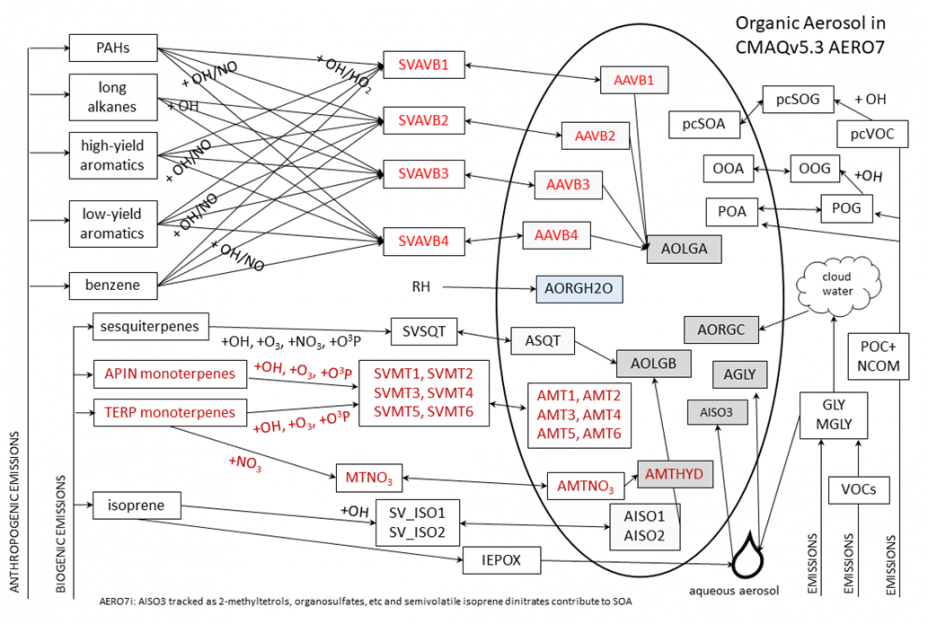
- Expanded chemistry for ozone and PM formation from global-to-local scales: CMAQ 5.3 updates the science behind the interactions of chemicals in the air and clouds (Fahey et al., 2017; Luecken et al., 2019; Sarwar et al., 2019). These advances reflect the state of the science and are more inclusive of chemical processes not just within the U.S., but under different climatic conditions across the globe.
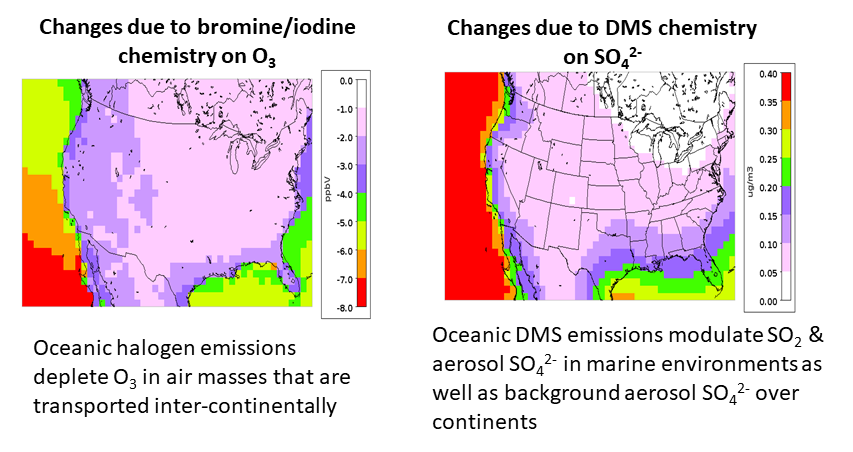
- More complex land and atmosphere interactions to support both air quality and ecosystems applications: CMAQ 5.3 includes two new options for simulating the exchange of pollutants between the land and the atmosphere, improving linkages of CMAQ for ecological applications (Bash et al., 2018;Pleim et al., 2019).
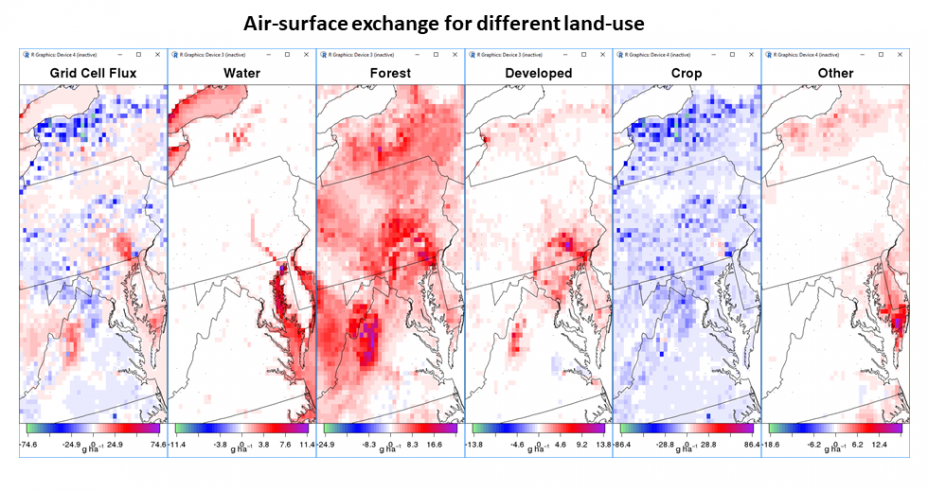
- Increased emphasis on pollutants originating outside the U.S.: While air quality has improved through EPA regulations under the Clean Air Act, understanding the fate of air pollutants originating in other countries remains critical for addressing air quality in the U.S. CMAQ 5.3 better captures the influences of reactive chemical species originating from the oceans, and it increases the emphasis on more accurate characterization of pollutants transported through the air from distant sources (Mathur et al., 2017; Hogrefe et al., 2018).
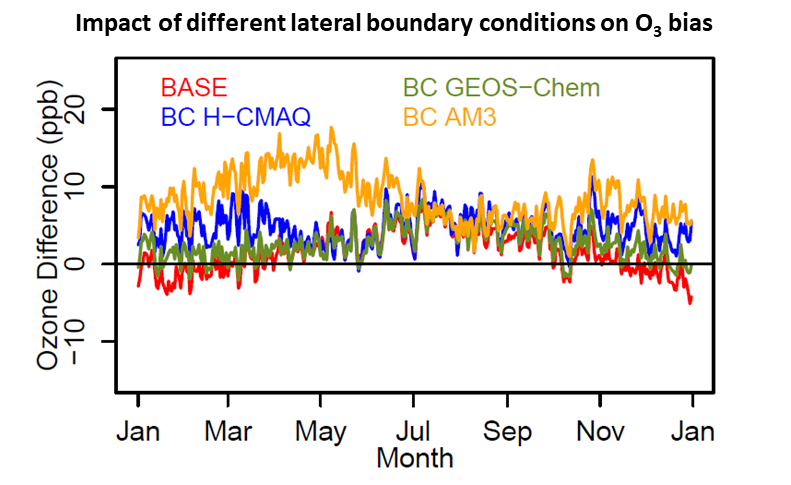
- Increased scientific consistency between meteorology and chemistry models: As the state of the science in the meteorology model evolves, changes are introduced into CMAQ to represent the atmospheric processes as consistently as possible between these models. The meteorology model used by CMAQ was updated by adding scientific complexity, incorporating new data sources, and changing the representation of the atmosphere above the troposphere—that is, above where most of the weather occurs. This change is important because intermittent infusions of high concentrations of ozone into the lower atmosphere occur through physical processes at the top of this layer -- the tropopause.
- Greater flexibility to support increasingly diverse uses of CMAQ: Some of the software in the CMAQ modeling system has been restructured so that both users and developers can more readily extend CMAQ to meet their needs. For example, a new emissions interface allows for substantial flexibility in the way emissions are mapped, scaled, and checked for quality and can greatly simplify the task of assessing air quality improvements resulting from emission changes.
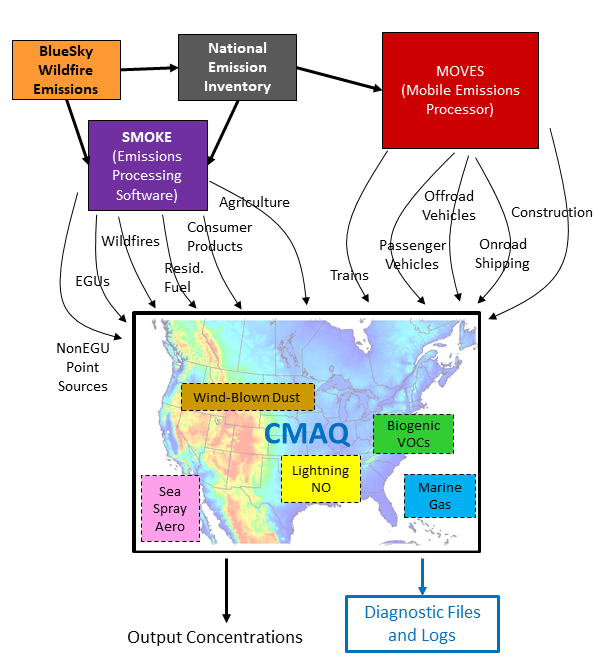
- Improved efficiency for CMAQ-ISAM for isolating source contributions to air quality: The science algorithms used by the Integrated Source Apportionment Method (CMAQ-ISAM) to track contributions from different emission sources to ozone and PM have been updated. Code improvements have led to substantially faster run times to support its practical applications.
- Fully revised documentation to better reflect CMAQ’s current structure and capabilities: A new comprehensive user’s guide provides instructions on setting up and running the model, including guidance on what model options are recommended for different types of modeling applications.
References
Bash, J. O., D. Schwede, P. Campbell, T. Spero, W. Appel, and R. Pinder (2018). Introducing the Surface Tiled Aerosol and Gaseous Exchange (STAGE) dry deposition option in CMAQ v5.3. Presented at 17th Annual CMAS Conference, 22–24 October 2018, Chapel Hill, NC.
Fahey, K. M., Carlton, A. G., Pye, H. O. T., Baek, J., Hutzell, W. T., Stanier, C. O., Baker, K. R., Appel, K. W., Jaoui, M., and Offenberg, J. H. (2017). A framework for expanding aqueous chemistry in the Community Multiscale Air Quality (CMAQ) model version 5.1, Geosci. Model Dev., 10, 1587-1605, https://doi.org/10.5194/gmd-10-1587-2017.
Hogrefe, C., Liu, P., Pouliot, G., Mathur, R., Roselle, S., Flemming, J., Lin, M., and Park, R. J. (2018). Impacts of different characterizations of large-scale background on simulated regional-scale ozone over the continental United States, Atmos. Chem. Phys., 18, 3839-3864, https://doi.org/10.5194/acp-18-3839-2018.
Luecken, D. J., G. Yarwood, and W. T. Hutzell (2019). Multipollutant modeling of ozone, reactive nitrogen and HAPs across the continental US with CMAQ-CB6, Atmospheric Environment, 201, 62-72, https://doi.org/10.1016/j.atmosenv.2018.11.060.
Mathur, R., Xing, J., Gilliam, R., Sarwar, G., Hogrefe, C., Pleim, J., Pouliot, G., Roselle, S., Spero, T. L., Wong, D. C., and Young, J. (2017). Extending the Community Multiscale Air Quality (CMAQ) modeling system to hemispheric scales: overview of process considerations and initial applications, Atmos. Chem. Phys., 17, 12449-12474, https://doi.org/10.5194/acp-17-12449-2017.
Pleim, J. E., Ran, L., Appel, W., Shephard, M. W., & Cady‐Pereira, K. (2019). New bidirectional ammonia flux model in an air quality model coupled with an agricultural model. Journal of Advances in Modeling Earth Systems, 11. https://doi.org/10.1029/2019MS001728.
Pye, H. O. T.; Murphy, B. N.; Xu, L.; Ng, N. L.; Carlton, A. G.; Guo, H. Y.; Weber, R.; Vasilakos, P.; Appel, K. W.; Budisulistiorini, S. H.; Surratt, J. D.; Nenes, A.; Hu, W. W.; Jimenez, J. L.; Isaacman-VanWertz, G.; Misztal, P. K.; Goldstein, A. H. (2017). On the implications of aerosol liquid water and phase separation for organic aerosol mass. Atmos Chem Phys, 17 (1), 343-369. https://doi.org/10.5194/acp-17-343-2017.
Pye, H. O. T., D’Ambro, E., Lee, B., Schobesberger, S., Takeuchi, M., Zhao, Y., Lopez-Hilfiker, F., Liu, J., Shilling, J., Xing, J., Mathur, R., Middlebrook, A., Liao, J., Welti,A., Graus, M., Warneke, C., de Gouw, J., Holloway, J., Ryerson, T., Pollack, I., Thornton, J. A. (2019). Anthropogenic enhancements to production of highly oxygenated molecules from autoxidation. P Natl Acad Sci USA. https://www.pnas.org/content/early/2019/03/12/1810774116.
Sarwar, G., B. Gantt, K. Foley, K. Fahey, T. L. Spero, D. Kang, R. Mathur, H. Foroutan, J. Xing, T. Sherwen, and A. Saiz-Lopez (2019). Influence of bromine and iodine chemistry on annual, seasonal, diurnal, and background ozone: CMAQ simulations over the Northern Hemisphere, Atmospheric Environment, 213, 395-404, https://doi.org/10.1016/j.atmosenv.2019.06.020.
Additional Information
- Access to the CMAQ GitHub RepositoryEXIT
- CMAQv5.3, v5.3.1, v5.3.2 Release NotesEXIT- a detailed description of major updates made in CMAQv5.3 and the bug fixes in v5.3.1 and v5.3.2.
- CMAQ Documentation and User Resources - directions on how to download and run the newest CMAQ model code, and information on resources to assist in operating CMAQ.
